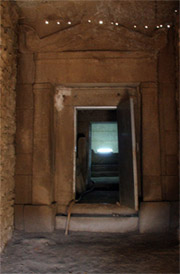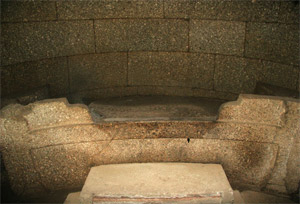Tomb of the Griffins
Tomb of the Griffins
It is located 12 km north of Kazanlak
The temple in the “Griffoni” mound was built in the 5th century BC, after which a prominent Thracian was buried in it. In the middle of the 4th century BC. the long and high corridor is filled with stones and dirt. The temple is named “Griffons” because of the heads of griffins depicted above the entrance – mythical monsters combining the symbols and bodies of a lion and an eagle. The construction of stone blocks is the most well-executed dome construction of this era, which distinguishes it from other monuments of Thracian architecture.
The temple in the “Griffoni” mound near the town of Shipka was opened on August 15, 1996. A long and high corridor, built of river stones and mud, leads to its facade. It, like the vestibule and the chamber, is built of well-worked granite blocks.
Columns are modeled from the stone blocks of the facade, and above them a false pediment, decorated at the edges with demi-palmettes, the main leaf of which is elongated, curved and pointed so as to resemble a griffin’s beak. In its upper part, the pediment ends with a plastically modeled palmette. Above the facade there was a roof covering of tiles, part of which has been preserved. Because of the modeled images on the pediment, the mound is called “Griffons”.
The temple in the “Griffoni” mound was built in the 5th century BC, after which a prominent Thracian was buried in it. In the middle of the 4th century BC. the long and high corridor is filled with stones and dirt. The temple is named “Griffons” because of the heads of griffins depicted above the entrance – mythical monsters combining the symbols and bodies of a lion and an eagle. The construction of stone blocks is the most well-executed dome construction of this era, which distinguishes it from other monuments of Thracian architecture.
The temple in the “Griffoni” mound near the town of Shipka was opened on August 15, 1996. A long and high corridor, built of river stones and mud, leads to its facade. It, like the vestibule and the chamber, is built of well-worked granite blocks.
Columns are modeled from the stone blocks of the facade, and above them a false pediment, decorated at the edges with demi-palmettes, the main leaf of which is elongated, curved and pointed so as to resemble a griffin’s beak. In its upper part, the pediment ends with a plastically modeled palmette. Above the facade there was a roof covering of tiles, part of which has been preserved. Because of the modeled images on the pediment, the mound is called “Griffons”.


An entrance was formed on the facade, which closed with a double-winged stone door. Through it one goes into a rectangular vestibule covered with a gabled roof of large stone blocks. A door identical to the door on the facade closed the entrance to the chamber. It has a round base and is covered with a dome. The floor of the vestibule and chamber is covered with stone slabs. The walls of the chamber show holes from metal nails that were found on the floor. The participants in the religious Thracian mysteries hung clothes and ritual objects on them.
Opposite the entrance to the burial chamber is a bed made of stone slabs. In front of the bed there is a stone block step plastered with plaster. Lion’s paws are modeled on the front of the foot and there is a joint colored “Pompean” red. The facility was looted in ancient times. The temple is an outstanding monument of Thracian architecture.
Opposite the entrance to the burial chamber is a bed made of stone slabs. In front of the bed there is a stone block step plastered with plaster. Lion’s paws are modeled on the front of the foot and there is a joint colored “Pompean” red. The facility was looted in ancient times. The temple is an outstanding monument of Thracian architecture.


